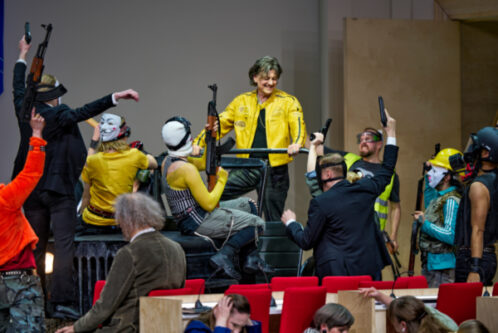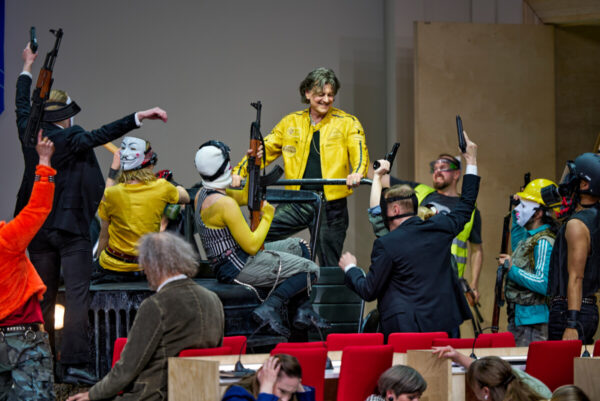 Sweden Verdi, Nabucco: Soloists, Chorus and Orchestra of Gothenburg Opera / Giancarlo Andretta (conductor). Gothenburg Opera main stage, 31.5.2023. (NS)
Sweden Verdi, Nabucco: Soloists, Chorus and Orchestra of Gothenburg Opera / Giancarlo Andretta (conductor). Gothenburg Opera main stage, 31.5.2023. (NS)

Production:
Direction – Jacopo Spirei
Set design – Mauro Tinti
Costume design – Silvia Aymonino
Lighting design – Giuseppe di Iorio
Assistant costume designer – Agnese Rabatti
Cast:
Nabucco – Mats Persson
Ismaele – Tomas Lind
Zaccaria – Mats Almgren
Abigaille – Zoya Tsererina
Fenena – Katarina Giotas
High Priest of Bel – Daniel Hayes
Abdallo – Daniel Ralphsson
Anna – Mia Karlsson
Nabucco is remarkably rarely performed in Sweden despite its fame as Verdi’s breakthrough opera. The first fully-staged performance had to wait until 1965 (!) and this production is the first fully-staged production by the Gothenburg Opera. Aided by Mauro Tinti’s sets and Silvia Aymonino’s costumes, director Jacopo Spirei gives us an uncompromisingly contemporary setting with the story playing out as an insurrection or civil war in a tired democracy. Act I takes place in a parliament chamber under siege by insurrectionists led by their charismatic leader Nabucco. Spirei’s direction and superb acting by the Gothenburg Opera chorus vividly shows the initially squabbling politicians being brought together by their shared predicament and by the leadership of Zaccaria.
Mats Almgren was a superb Zaccaria, with his voice carrying over the chorus in ‘Come notte a sol fulgente’ and a magnetic stage presence. He was also gripping in his solo parts, including the mellow ‘Vieni, o Levita’ with beautiful accompaniment from the cello section. By this point Zaccaria is now the leader of underground resistance to the new fascist regime – during this aria he is busy handling explosives. This is one of a number of moments where the direction clashes noticeably with the libretto. Setting Act II inside the same parliament chamber as the first act also felt a bit confusing.
Mats Persson made an impressive opponent to Zaccaria. His Nabucco is a virile warrior and charismatic dictator but also a loving father. Persson’s depiction of Nabucco’s hubris and descent into madness at the end of the second act was gripping, and his confrontation with Abigaille after he finds he has been tricked into signing Fenena’s death warrant was a moving picture of the human being behind the dictator.

Zoya Tsererina’s Abigaille is a more extreme version of Nabucco himself (in this production also sartorially – she wears more leather than her father). Tsererina’s dramatic soprano was perfect for this very demanding role, both in the ensemble scenes and in her arias in Act II, but most of all in her fiery confrontation with Nabucco in Act III. Her acting was also brilliantly judged, embodying Abigaille’s arrogance one she had taken power even with her body language.
The love story in the libretto pales against the religious-political drama and in this production it becomes even more of a fig leaf explaining how Nabucco’s daughter Fenena (Katarina Giotas) is ‘converted to democracy’. Giotas came into her own with her moving aria ‘O dischiuso è il firmamento’ in Act IV, where she serenely prepares to face her death. Tomas Lind believably expressed Ismaele’s feelings in his opening duet with Fenena but found himself overshadowed in ensemble scenes.
Daniel Hayes made a convincingly scary High Priest of Bel, especially when accompanied by his black-clad masked soldiers. The superb costume design and atmospheric lighting really brought out the contrasts between the Israelites/democrats, Nabucco’s loyalists and the sinister regiment of fascist fundamentalists that put Abigaille in power. Acts III and IV take place in and outside a prison camp, a moving setting for ‘Va, pensiero’ and effective for the drama.
Ultimately occasional quibbles with the director’s concept are trumped by the superb musicianship displayed throughout. Giancarlo Andretta has conducted a number of excellent productions in Gothenburg and he had a great sense of the musical drama and pacing. The Gothenburg Opera Orchestra responded superbly and were rightly given enthusiastic ovations already after the interval. The chorus is perhaps the most important ‘character’ in this opera and the Gothenburg Opera Chorus sang with a passion and sensitivity which was wonderful to hear.
Playing until 10 June, then 26 August-23 September. On 7 and 10 June Fenena will be sung by Ann-Kristin Jones. In the autumn revival High Priest of Bel will be sung by Kristian Lindroos. Aivis Greters conducts some performances. (Tickets and more information at the Gothenburg Opera website.)
The premiere (with Ann-Kristin Jones as Fenena) was broadcast on Swedish Radio and is available to stream until 19 June in the SR Play app and on the Swedish Radio website (click here).
Niklas Smith
